Synergistic Effect on Ternary Blended Cementitious System
Jasir Thachaparambil Lecturer, Department of Civil Engineering, SSM Polytechnic College, Tirur, Kerala, IndiaABSTRACT
This paper presents a detailed experimental investigation on the synergestic effects on ternary blended cementitious system containing fly ash and silica fume. The experimental programme consisted of three parts, the first part was to obtain the super plasticizer demand for each mix so as to obtain a workability of 110±5%,thesecondpartwastodeterminethestrengthanddurability properties of the mortar samples having different fly ash and silica fume contents and the third part was to determine the synergy existingintheternaryblendsbothintermsofdurabilityandstrength Test results have shown that the ternary blended mixtures improved the mortar performance by improving the workability, strength and durability, therefore are applicable. Ternary mixtures performed in accordance with their ingredients; however the degree of improvementthattheycontributevariesbasedontheselecteddosage andtypeofSCMs.Synergybetweentheflyashandsilicafumeisthe mainreasonfortheoutstandingperformanceofternarymixtures.The results obtained thus are encouraging for partial replacement.
KEYWORDS: Synergicaction;Ternaryblendedconcrete;Durability; Fly ash; Silica fume; Concrete
1. INTRODUCTION
1.1. GENERAL
Cementisthemostwidelyusedconstructionmaterial in the world. Due to the huge quantity of consumption, its performance and environmental footprint on the earth are of great importance. Sustainability and durability have become the major concern of the construction industry.
1.1.1. Environmental Impacts of cement production
Energy consumption is the biggest environmental concern with cement production. Cement production is the most energy intensive of all the industrial manufacturingprocesses. Includingdirectfuelusefor mining and transportation of raw materials, cement production takes about 1758KWh for every ton of cement.
The industry’s heavy reliance on coal leads to especially high emission levels of carbon dioxide, nitrous oxide and sulphur among other pollutants. Thus Portland cement is not only one of the most energy intensive materials of construction but also is responsible for a large amount of greenhouse gas emissions. The world’s yearly cement production of 1.6 billion tones accounts for about 7-8% of global loading of carbon dioxide into the atmosphere.
How to cite this paper: Jasir Thachaparambil "Synergistic Effect on Ternary Blended Cementitious System" Published in International Journal of Trend in Scientific Research and Development (ijtsrd), ISSN: 2456-6470, Volume-6 | Issue-7, December 2022, pp.194-223, URL: www.ijtsrd.com/papers/ijtsrd52289.pdf
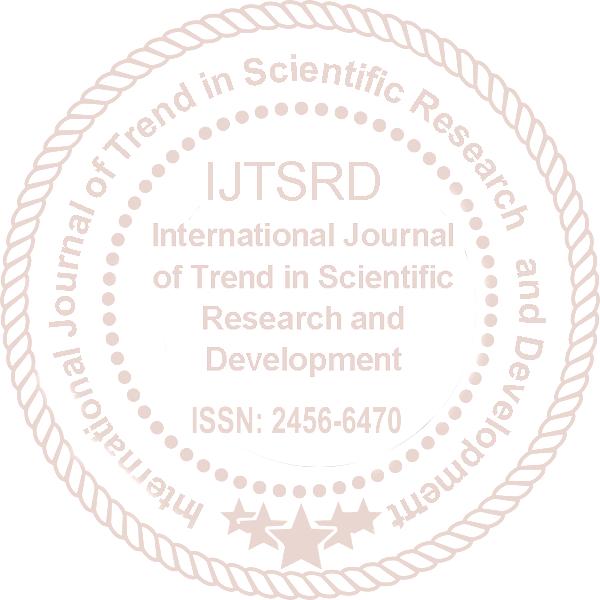
Copyright © 2022 by author (s) and International Journal of Trend in Scientific Research and Development Journal. This is an Open Access article distributed under the terms of the Creative Commons Attribution License (CC BY 4.0) (http://creativecommons.org/licenses/by/4.0)

There are two different sources of carbon dioxide emissions during cement production, namely the combustion of fossil fuels to operate the rotary kiln and the chemical process of calcining limestone into lime. Combining these two sources, for every ton of cement production approximately one ton of carbon dioxideisreleasedintotheatmosphere.Furthermore, mining large quantity of raw materials, such as limestone and clay, and fuel such as coal, often results in extensive deforestation and top soil loss.
The environmental impact of the construction industrycanbereducedthroughresourceproductivity i.e.byconservingmaterials and energyin thecement production and by improving durability of concrete products. Cement conservation is the first step in reducingtheenergyconsumptionandgreenhousegas emissions.
One of the efforts to mitigate the environmental issues associated with cement production includes partial replacement of cement with supplementary cementitious materials like fly ash, silica fume, rice husk ash etc. Using supplementary cementitious materials (SCMs) is an effective way of reducing carbon footprint of our cement production.
1.1.2. Durability and quality of structures
Construction industry is becoming increasingly complex and the importance of building structures that are both cost effective and durable has never been higher. Achieving durability in construction shouldbeaveryimportantconsiderationinthedesign and construction of new structures. Concrete structuresaregenerallydesignedforservicelifeof50 years, but experience shows that in urban and coastal environment many structures begin to deteriorate in 20 to 30 years or even lesser time.
Durabilityofastructureisitsresistancetoweathering action, chemical attack, abrasion and other degradation process. Mineral additions have been an important tool to aid durability of concrete structure and thus came the concept of blends.
In recent years, many researchers have established that waste materials like fly ash, blast furnace slag, silica fume, metakaolin, rice husk ash etc. may be usedasapartialreplacementofcement,whichleadto economy and in addition by utilizing the industrial wastesinausefulmannertheenvironmentalpollution is also reduced to a great extent and which in turn leads to sustainable development. Blends offer significant advantages over conventional system of Portland cement alone. They can produce stronger and more durable concrete and possess a long and impressive track record. Blends are also suitable for harsh environment where concrete is likely to be exposedtomoisture,extremeweatherandchemicals. Moreover blends are more environment friendly.
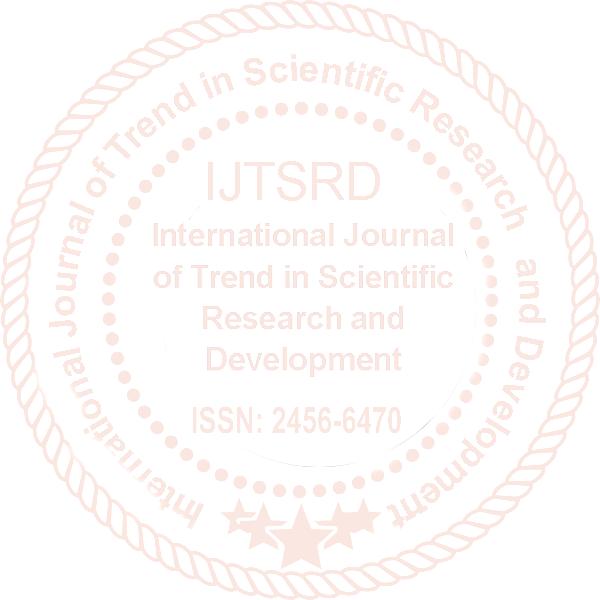
1.2. FLY ASH
Fly ash (FA) is the most widely used supplementary cementitious material in concrete; ASTM C 618-89 definesflyashas“afinelydividedresiduethatresults from combustion of ground or powdered coal”. Itisabyproductofthecombustionofpulverizedcoal in electric power generating plants. Upon ignition in the furnace, most of the volatile matter and carbon in thecoalareburnedoff.Duringcombustion,thecoal’s mineralimpurities(suchasclay,feldspar,quartz,and shale) fuse in suspension and are carried away from the combustion chamber by the exhaust gases. In the process, the fused material cools and solidifies into spherical glassyparticles calledflyash.Theflyashis thencollectedfrom theexhaustgasesbyelectrostatic precipitators or bag filters.
Two classes of fly ash are defined by ASTM C 61889, Class F fly ash and Class C fly ash. The chief difference between these classes is the amount of calcium, silica, alumina, and iron content in the ash. The chemical properties of the fly ash are largely influencedbythechemicalcontentofthecoalburned
(i.e.,anthracite,bituminous,andlignite).Theburning of harder, older anthracite and bituminous coal typically produces Class F fly ash. This fly ash is pozzolanicinnature,andcontainslessthan20%lime.
Class C Fly ash is produced from the burning of youngerligniteorsub bituminous coal, in addition to having pozzolanic properties, it also has some selfcementing properties. Class C fly ash generally contains more than 20% lime (CaO).
Fly ash is a finely divided powder resembling Portland cement. Most of the fly ash particles are solid spheres and some are hollow cenospheres. Ground materials, such as Portland cement, have solid angular particles. The particle sizes in fly ash vary from less than 1 μm (micrometer) to more than 100 μm with the typical particle size measuring less than 20 μm. Only 10% to 30% of the particles by mass are larger than 45 μm. The surface area is typically 300 to 500 m2/kg, although some fly ashes can have surface areas as low as 200 m2/kg and as high as 700 m2/kg. For fly ash without close compaction, the bulk density (mass per unit volume including airbetween particles)can varyfrom540 to 860 kg/m3 whereas with close packed storage or vibration, the range can be 1120 to 1500 kg/m3. The relativedensity(specific gravity) of flyash generally ranges between 1.9 and 2.8 and the color is generally gray or tan.
1.2.1. Pozzolanic action Class F and Class C fly ashes are commonly used as pozzolanic admixtures for general purpose concrete. During the hydration process of cement, along with the binding gel (C-S-H gel) lime isreleased out and remains as surplus in the hydrated cement. This leached outsurplus lime renders deleterious effect to concrete such as make the concrete porous which in turn give chance to the development of micro cracks, weakening the bond with aggregates and thus affect the durability.
If fly ash is available in the mix, this surplus lime becomes the source forpozzolanic reaction with fly ash and forms additional C-S-H gel having similar binding properties in the concrete as those produced byhydration of cement paste. The reaction of fly ash with surplus lime continues as long as lime is present in the pores of liquid cement paste.
Fig 1.1 Pozzolanic action of fly ash
Flyashisusedinabout50%ofreadymixedconcrete. Class F fly ash is often used at dosages of 15% to 25%bymassofcementitiousmaterialandClassCfly ash is used at dosages of 15% to 40% by mass of cementitious material. Dosage varies with the reactivity of the ash and the desired effects on the concrete.
1.3. SILICA FUME
Silica fume (SF), also referred to as microsilica or condensedsilicafume,isaby-productmaterialthatis used as a pozzolan. This by-product is a result of the reductionofhigh-purityquartzwithcoalinanelectric arc furnace in the manufacture of silicon or ferrosilicon alloy. Silica fume rises as an oxidized vapour from the 2000°C (3630°F) furnaces. When it coolsitcondensesandiscollectedinhugeclothbags. The condensed silica fume is then processed to remove impurities and to control particle size. Condensed silica fume is essentially silicon dioxide (usually more than 85%) in non-crystalline (amorphous) form. Since it is an airborne material like fly ash, it has a spherical shape. It is extremely fine with particles less than 1 μm in diameter and with an average diameter of about 0.1 μm, about 100 times smaller than average cement particles. Condensed silica fume has a surface area of about 20,000 m2/kg. The relative density of silica fume is generally in the range of 2.2 to 2.5. The bulk density of silica fume varies from 130 to 430 kg/m3 1.3.1. Silica fume as a supplementary cementitious material
Because of its extreme fineness and high silica content, silica fume is a highly effective pozzolanic material. Silica fume is used in concrete to improve its properties. It has been found that silica fume improves compressive strength, bond strength and abrasion resistance and reduces permeability, and therefore helps in protecting reinforcing steel from corrosion.Silicafumeisusedinamountsbetween5% and 10% by mass of the total cementitious material.
The benefits seen from adding silica fume are the result of changes to the microstructure of the concrete.Thesechangesresultfromtwodifferentbut equally important processes. The first of these is the physical aspect of silica fume and the second is its chemical contribution.
Physical contributions
Adding silica fume brings millions and millions of very small particles to a concrete mixture. Just like fine aggregate fills in the spaces between coarse aggregate particles, silica fume fills in the spaces between cement grains. This phenomenon is frequently referred to as particle packing or microfilling. Even if silica fume did not react chemically, the micro-filler effect would bring about significant improvements in the nature of the concrete.
Chemical contributions
Because of its very high amorphous silicon dioxide content, silica fume is a very reactive pozzolanic material in concrete. As the Portland cement in concrete begins to react chemically, it releases calcium hydroxide. The silica fume reacts with this calciumhydroxidetoformadditionalbindermaterial called calcium silicate hydrate, which is verysimilar to the calcium silicate hydrate formed from the Portland cement. It is largely this additional binder thatgivessilica-fumeconcreteitsimprovedhardened properties.

1.3.2. Applications of silica fume
High performance concrete (HPC) containing silica fume for highway bridges, parking decks, marine structures and bridge deck overlays.
High-strengthconcreteenhancedwithsilicafume for greater design flexibility.
Silica-fumeshotcreteforuseinrockstabilization; mine tunnel linings, and rehabilitation of deteriorating bridge and marine columns and piles.
1.4. BINARY AND TERNARY BLENDS

Blends are a mixture of multiple ingredients combined with Portland cement. Blends can be divided into two main categories binary blends and ternary blends. Binary is a mixture of two products i.e. Portland cement and one supplementary cementitious material, whereas the ternary blend is a mixture of three products, Portland cement and two supplementary cementitious materials. The type and proportionofSCMsincludedintheblendsestablishes the performance in concrete.
WhenOPChydratesC-S-H(calciumsilicatehydrate) gelis formed, this glue holds concrete together, However gaps in the glue provide pathways for moisture to penetrate and reduce strength. When
SCMs are added particles pack more tightly within the voids and additional glue forms from the SCM hydration process and result in fewer voids in the matrix thereby less permeability and more strength and durability.
IncorporatingasingleSCMtoimproveconcretemay havesomelimitations suchas lowearlyagestrength, extended curing periods, increased plastic shrinkage cracking etc. The use of appropriately proportioned ternary blends allows the effect of one SCM to compensate for the inherent shortcomings of other, which is termed as the synergistic effect.
1.5. SYNERGY IN TERNARY BLENDED CEMENTITIOUS SYSTEM
Synergy describes the interaction of two or more agents or forces so that their combined effect is greater than sum of their individual effects.
The advantages of using binary blends of either fly ash or silica fume in partial replacement of Portland cement in mortar and concrete is well known. Howeverbothmaterialshavecertainshortfalls.Silica fume while imparting significant contribution to concrete strength and chemical resistance can create increase in water demand, placing difficulties and plastic shrinkage problems if not properlyused. Low calcium flyash generallyprovides goodresistance to alkali-silica reaction and sulphate attack. However strengthdevelopmentatearlyagesistypicallyslower than that in conventional Portland cement systems especially at higher levels of replacement. But when combined in a ternary system, fly ash compensates for the deficiencies of silica fume and vice versa, silica fume compensates for the deficiencies of fly ash.
Inthepresentstudy,strengthanddurabilityproperties of binary and ternary blended mortars of fly ash and silica fume were investigated.
1.5.1.
Quantification of Synergy
Thomas et al. (1999) proposed an equation to predict the theoretical value for any of the properties of a ternary system and thereby gave a method to quantitatively assess synergy existing in a ternary blended system.
The theoretical value of any predicted property for a mix, [F(15)S(5)] was approximated using the following equation:

fractions of respective OPC and FA in binary mix F (15) S (0) and OPC and SF in mix S(5)F(0).
Then the magnitude of the synergistic effect was calculated from the following equation: Where;
S.E = synergistic effect (%)
P 15F/5S= measured value of a given property for the 15FA/5SF mixture
P theor 15F/5S = theoretical value of a given propertyfor the 15FA/5SF mixture
j = 1 for properties to be maximized (compressive strength) and j = -1 for properties to be minimized (rapid chloride permeability and initial sorptivity).
2. LITERATURE REVIEW

2.1. GENERAL
Keepinginviewtheobjectivesofthestudy,adetailed literature survey was conducted, in the domain of both binary and ternary cementitious systems. Large volumeofliteratureis availablein thefield andafew of them are summarised here.
(1) "Use of ternary cementitious systems containing silica fume and fly ash in concrete", M.D.AThomas(1999)conductedlaboratorystudies on durability of concrete that contains ternary blend of Portland cement, silica fume and a wide range of fly ashes.
Theresultsobtainedshowedthatternarycementitious blends of Portland cement, silica fume and fly ash offer significant advantages over plain Portland cementconcrete.The combinationofsilicafumeand low CaO fly ash is complementary; the silica fume improves the earlyage performance of concrete with theflyash continuouslyrefining theproperties ofthe hardenedconcreteasitmatures.Intermsofdurability such blends are vastly superior to plain Portland cementconcrete.Theyfoundthatcombinationsof3-5 % silica fume with 20-30% high CaO show satisfactory performance in both ASR and Sulphate expansion tests. They concluded that such combinations produce concrete with generally excellent properties and offset the problems associated with using the increased amounts of high CaO fly ash or silica fume required when these materials are used individually.
Where P OPC, P15F, P5S are the values of a given property for OPC, F(15)S(0), and S(5)F(0) mixtures, respectively. 0.95 and 0.85 represent sum of volume
(2) "Porosity and strength of PFA/SF/OPC ternary blended paste", Khan et al. (2000) conducted studies on a ternary blended cementitious system of ordinary Portland cement (OPC)/ pulverised fuel ash (PFA)/ silica fume (SF) for the development ofhigh-performanceconcrete.Cement
pastes covering a wide range of PFA/SF blending proportions were investigated. They found that increase in PFA content was associated with reduction in strength and increase in porosity in comparison with the OPC control paste for all ages investigated. As SF was incorporated as a cement replacement alone, early -age strength was slightly increased and porosity was slightly reduced. However, as PFA was introduced in the ternary blended systems, the strength was reduced and porosity increased. Although none of the ternary blendedsystemsachievedthestrengthandporosityof the OPC control, these systems are viable when economic and environmental benefits are sought given the level of performance achieved.
(3) "Effects of densified silica fume on the microstructure and compressive strength of blended cement pastes", Rao (2003) reported the influence of silica fume (SF) on various preliminary properties of cement pastes and mortars. Specific gravity, air content and workability decrease as the addition of SF increases. The SF seemed to be an efficient pozzolanic material. It activates the constituentsofcementintheearlyhoursofhydration. The air content has been reduced due to its microfillingeffect, which may lead to increase the compressivestrength.Quicksettingofcementresults with higher SF contents. The positive trends have been observed with SF on strength of mortars and soundness. The drying shrinkage of mortar increases as the SF content increases. The optimum SF content forachievinghigherstrengthofmortarswasfound to be between 15% and 22%.
(4)"Strength,porosityandcorrosionresistanceof ternary blend Portland cement, rice husk ash and flyashmortar",Chindaprasirtetal. (2008)studied the strength, porosity and corrosion resistance of mortars made with ternary blends of ordinary Portland cement (OPC),ground rice husk ash (RHA) and classified fly ash (fine fly ash, FA). The results show that the use of ternary blend of OPC, RHA and FA significantly improves the mortar in terms of strength at the low replacement level and at the later age. The resistance to chloride-induced corrosion of mortar containing pozzolanis significantly improved in comparison to that of OPC mortar. Both FA and RHA are very effective in improving the corrosion resistance of mortars. RHA is slightlymore effective thanFA.Thecorrosionresistanceoftheternaryblend mortar is consistently higher than that of mortar containing single pozzolan. At high replacement of 40% of pozzolan, although the porosity of mortar is increased at the age of 28 days as compared to OPC mortar, the corrosion resistance is significantly
improved. This suggests that pore refinement and reduction in calcium hydroxide play important roles in the corrosion resistance of ternaryblend OPC, FA and RHA mortar.

(5) "Evaluation of binary and ternary blends of pozzolanic materials using rapid chloride penetration test", Ahmed et al. (2009)studied the effect of replacing cement by pozzolanic materials.The materials used were fly ash, blast furnace slag (BFS), and silica fume. The blending was at the increasing levels of 25, 50, and 70% of fly ash or BFS,with or without addition ofsilica fume at 10% cement replacement to form binary and ternary blends. The results indicated that an increase in fly ash content increased the charge passed in the specimens but the reverse trend was observed with increase in the BFS content in the absence of silica fume. Silica fume alone as well as its ternary blend with 25% fly ash showed lower charge when comparedwiththecontrolorwiththebinaryblendof cement and fly ash. However, in ternary blends containing fly ash at more than 25%, the presence of silica fume did not cause a reduction in the charge. All ternary blends comprising BFS and silica fume passed lower charges than the respective binary blends. These ternary blends exhibited dense microstructurecompared tothecorrespondingbinary flyashblends.Thehighestpercentagereplacementof cement with 70% BFS and silica fume was comparable with the addition of silica fume alone. The results showed that concretes with BFS blends exhibit lower charge passed and higher compressive strength than comparative blends using fly ash.
(6) "Utilisation of fly ash with silica fume and propertiesofPortlandcement-flyash-silicafume concrete", Nochaiyaet al. (2009) investigated ternary blends of fly ash, silica fume andPortland cement using an extensive range of mixes: fly ash from 5% to 30%, and silica fume at 2.5%, 5% and 10%.Fresh properties,in terms of the setting time of cementpasteandtheworkabilityoftheternaryblend concrete,wereinvestigated.Compressivestrength of the ternary concrete was tested and analyzed relative to both a Portland cement (PC) control and reference fly ash mixes.
From the study it was concluded that water requirement of fly ash pastes with silica fume was found to have higher water demand than the mixes without silica fume and the setting time was found to reduce with increasing silica fume content. The utilization of silica fume with flyash in concrete was found to increase the compressive strength of concrete mixes. The workability was found to
decrease, but still remained similar to or higher than the control mix.
Moreover, the high compressive strength of blended Portland cement –fly ash–silica fume concretes was due to both the filler effect and the pozzolanic reaction of silica fume evidently giving the cement matrix a denser microstructure, therebyresulting in a significant gain in strength. The utilization of fly ash with silica fume not only improve the concrete strength, it allows the use of another by-product (silica fume) which is much finer, with fly ash, each givingitsbenefitandasacombinationallowingmore mixture to be used while maintaining good fresh concrete properties. In addition, the use of both byproductswouldofferecologicalbenefitaswellwhich help cutting down the use of Portland cement while improving the properties to fly ash concrete.
(7) "Effect of water to binder ratio, air content and type of cementitious materials on fresh and hardened properties of binary and ternary blended concrete" by Yurdakulet al. (2013) investigated the effect of water-to-binder ratio (w/b), air content, and type of cementitious materials on fresh and hardened properties of binary and ternary blended concrete mixtures in pavements.

In this experimental program, a total matrix of 54 mixtures with w/b of 0.40 and 0.45; nominal air content of 2%, 4% and 8%; and three types of supplementary cementitious materials (SCMs) and one ordinary Portland cement at different combinationswasprepared.Bindersystemsincluded ordinary Portland cement, binary mixtures with slag cement, Class F and C fly ash, and ternary mixtures containingacombination ofslagcementandonetype of fly ash.
It was seen that when w/b was kept constant, increasingaircontent generallyhadaminoreffect on slightlyincreasingworkability. The ternarymixtures slightly retarded the setting time consistent with the effects of their ingredients. Binary and ternary mixtures containing Class C fly ash and slag cement exhibited higher compressive strength than the control mixture. The addition of Class C fly ash in binary mixtures generally showed a lower performance than the ones with Class F fly ash. Ternary mixtures overall performed better than control mixtures as they increased the strength and decreased the permeability.
2.2.
fly ash and silica fume in improving the strength and durability properties of cement mortar is not well established. In the present study the benefits of combining fly ash and silica fume in cement mortar and the synergy existing in the system were studied. And efforts are made to find an optimum dosage of flyash andsilicafumein aternaryblended system of OPC/FA/SF.
2.2.1. Objective of work
1. To study the strength & durability properties of ternary blended mortar consisting of OPC, FA and SF.
2. To verify whether synergistic effects exist in a ternaryblended cementitious system of OPC, FA and SF.
3. To quantify the magnitude of synergy in the OPC/FA/SF system.
2.2.2.
Scope of Work
The scope of the study was limited to 1:3 mortar specimens with OPC 53 grade, class F fly ash and silicafume.Watertobinderratiowasfixedas0.5and the following replacement levels of flyash and silica fume were used: FA: 0%, 15%, 30% SF: 0%, 5%, 10%
The compressive strength tests were conducted after 7, 28, 56 and 90 days of water curing. Flexural strength test were conducted on specimens subjected to 28 days and 90 days of water curing. Durability testsarecarriedoutafter3daysofinitialwatercuring (for initial hydration) after which the specimens will be exposed to the respective chemical solution for a time period of 7, 28, 56 and 90 days
3. EXPERIMENTAL PROGRAMME
3.1.
GENERAL
Theexperimentalprogrammeconsistedofthreeparts, the first part was to obtain the super plasticizer demand for each mix so as to obtain a workability of 110±5%, the second part was to determine the strength and durability properties of the mortar samples having different fly ash and silica fume contents and the third part was to determine the synergyexistingintheternaryblendsbothintermsof durability and strength.
3.2.
OBJECTIVE AND SCOPE OF WORK
Based on the literature reviewed in the previous section, it can be seen that addition of fly ash and silicafumeimproves the propertiesofthe mortar and concrete. However the benefits of a combination of
MATERIALS
The materials used for the experimental work are ordinary Portland cement 53 grade, class F fly ash, silica fume, M sand, super plasticizer and water.
3.2.1. Ordinary Portland Cement (OPC) OPC 53 grade, conformingto IS 12269, was used for the experimental work. Laboratory tests were conductedto determinethespecific gravity, standard consistency,fineness,initialsettingtime,finalsetting
time and the compressive strength. All tests were done as specified by IS 4031 (Part 1 to Part 5).The results are as shown in the Table 3.1.The chemical composition of cement was tested at Indian Institute of Technology (IIT) Madras and the results are presented in Table 3.2.
Table
Table 3.3 Sieve analysis of Fly ash
Particle retained on 45 micron sieve (%) Requirement (IS 3812(part1):2003) 30 34

Table 3.4 Chemical composition of fly ash
Chemical Component % by mass
SiO2 60.28 Al2O3 31.76 Na2O 2.10 P2O5 1.42 SO3 0.97 Fe2O3 0.89 CaO 0.72 K2O 0.69 TiO2 0.64 MgO 0.52
Table
3.2.2.
Fly ash
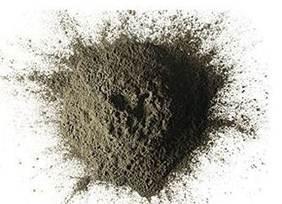
Class F fly ash was used for the experimental work and it was collected from Neptune Ready Mix Concrete plant, Trivanananthapuram. The specific gravity the fly ash was found to be 2.08. Fineness of flyash were found out by wet sieve analysis using 45µm sieve.Result is shown in Table 3.3. The chemical composition of fly ash was tested at Indian Institute of Technology (IIT) Madras, and is presented in Table 3.4.Fig 3.2 shows the scanning electron microscope (SEM) images of FA obtained from IIT Madras.
Fig 3.2 SEM images of fly ash

3.2.3. Silica fume
Silica fume used for the experimental work was obtained from ELKEM Materials. From the laboratory tests, thespecific gravity was obtained as 2.2 and density as 0.784 g/cc. Chemical composition of Silica Fume obtained from Indian Institute of Technology (IIT) Madrasis shown in Table 3.5.Fig 3.4showsthescanningelectronmicroscopicimageof SF as obtained from IIT Madras.
Figure 3.3 Silica fume
Fig 3.1 Fly ash
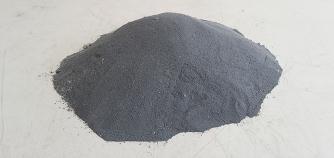
Table 3.5 Chemical composition of silica fume Oxide Content (%)
CaO 2.94 SiO2 84.28 Al2O3 1.54 Fe2O3 3.47 SO3 2.34 MgO 2.09 P2O5 0.60 TiO2 0.04 Na2O 1.23 K2O 1.47
3.2.4. Fine Aggregates
Fig
3.4 SEM image of silica fume

Locallyavailable M Sand was used as fine aggregate. Laboratorytests were conducted, as per IS: 383-1970, to determinethedifferentphysicalpropertiesofMsand.ThedetailsofparticlesizedistributionaregiveninTable 3.6 and the grading curve is as represented byFig. 3.3. The properties of fine aggregates are as shown in Table 3.7.

Table 3.6 Sieve analysis of Fine aggregate
Sieve size (mm) Weight retained in each sieve (kg) Cumulative weight retained (kg)

passing IS Range for zone II 4.75 0 0 0 100 90 – 100 2.36 0.004 0.004 0.4 99.6 75 – 100 1.18 0.317 0.321 32.1 67.9 55 – 90 0.6 0.329 0.65 65 35 35 – 59 0.3 0.267 0.917 91.7 8.3 8 – 30 0.15 0.063 0.98 98 2 0 – 10
Fig.3.3. Gradation curve of fine aggregate
Table 3.7 Properties of fine aggregate. Sl. No. Particulars Values
1 Specific gravity 2.50 2 Fineness Modulus 3.062 3 Grade Zone II
3.2.5. Water Clean and potable water available in the college water supply system was used for the work.
3.2.6. Super plasticiser
ConplastSP430suppliedbyM/sFosrocChemical(India)Pvt. Ltdwasusedassuperplasticiser.ConplastSP430 is based on SulphonatedNapthalenePolymers and supplied as a brown liquid instantly dispersiblein water. Conplast SP430 has been specially formulated to give high water reductions up to 25% without loss of workability or to produce high quality concrete of reduced permeability. The properties of Conplast SP430 as specified by the suppliers are as shown in Table 3.8.
Table 3.8 Properties of Conplast SP430 Specific Gravity Typically 1.20 at 20°C Chloride content Nil Recommended dosage 0.7 to 2.0 L/100kg of cement
3.3. MIX PROPORTION AND METHODOLOGY
3.3.1.
Mix proportion
Mortarsamples werepreparedin theratio1:3 byweight, i.e.onepartofcementitious materials tothreeparts of fine aggregate.
Inthisstudyflyashandsilicafumecontentswereeachexpressedaspercentagebyweightoftotalcementitious materials. Three fly ash contents namely 0%, 15% and 30% and three silica fume contents 0%, 5% and 10% were adopted for the design of mortar samples. In total there are 9 mixes, one control mix with 0% fly ash and 0%silicafume,twobinarymixesofflyashandOPC,twobinarymixesofsilicafumeandOPCandfourternary mixes.ThedetailedmixproportionsofthemortarsamplesaretabulatedinTable3.9.Themixnumbersaregiven intheformatF(X)S(Y)whereFrepresentflyash,SrepresentsilicafumeandX,Ydenotespercentageofflyash and silica fume in the mix respectively.
Table 3.9 Mix Proportions
SL NO: Mix OPC (%) FA (%) SF (%) Type
3.3.2. Methodology

F(0)S(0) 100 0 0 Control Mix 2 F(15)S(0) 85 15 0 Binary Mix 3 F(30)S(0) 70 30 0 Binary Mix 4 F(0)S(5) 95 0 5 Binary Mix 5 F(0)S(10) 90 0 10 Binary Mix 6 F(15)S(5) 80 15 5 Ternary Mix 7 F(30)S(5) 65 30 5 Ternary Mix 8 F(15)S(10) 75 15 10 Ternary Mix 9 F(30)S(10) 60 30 10 Ternary Mix
1
3.3.2.1. Determination of superplasticiser demand Superplasticiser demand for each mix was determined using flow table test to obtain a workabilityof 110±5%.
3.3.2.2. Mixing
Cementitiousmaterials,fineaggregates,waterandsuperplasticizerweretakeninrequiredproportionsandeach mortar sample was prepared using a standard mortar mixer. OrdinaryPortland cement, fly ash, silica fume and fine aggregates were first drymixed in the mixer for about three minutes and then water and superplasticizer is added and further mixed for three minutes to get a homogeneous mix.
Fig 3.6 Mortar mixer

3.3.2.3.
Casting of specimens
Mortarwas cast into cubes, beams anddiscs.Standardmoulds namely,50mm X50mm X50mm cubemoulds, 40mmX40mmX160mmbeammouldsanddiscmouldsof150mmdiameterand50mmthicknesswereusedfor casting.Themortarmixwerefilledinthemouldsandvibratedusingavibratingtable.Thesurfaceofthemortar were then finished using a trowel.
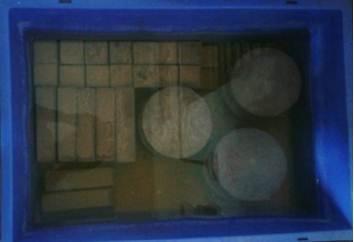
3.3.2.4.
Curing Regime
Allspecimenswerekept undisturbedfor24hoursandthenweighedtoobtaintheirdryweightsandsubsequently were subjected to water curing until the test ages were reached. The samples for durability studies were transferred to respective acid and sulphate solution after three days of water curing.
Fig 3.7 Curing of mortar specimens
Details of the specimens used for testing are given in Table 3.9

3.4.
WORKABILITY OF MORTAR
Workabilityofmortarisitseaseofusemeasuredbytheflowofthemortar.Superplasticiserdemandforeachof the nine mixes, to get a workability of 110±5% were determined by the flow test. The standard flow tests uses a standard conical frustum shape of mortar with a diameter of four inches. This mortar sample is placed on a flow table and dropped 25 times within 15 seconds. As the mortar is dropped, it spreads out on the flow table. The initial and final diameters of the mortar sample are used to calculate flow. Flow or workability is defined as the increase in diameter divided by the original diameter multiplied by 100.
Figure 3.8 Flow Test
3.5. TESTS CONDUCTED

3.5.1. Compressive strength test
Compressive strength test measures the resistance of samples to gradually applied crushingload. Compressive strength of hardened mortar is the most important of all the properties.Therefore mortar is always tested for its strength before it is used in important works. The test was conducted as per IS 2250-1981, on 50mm x50 mmx 50mm cubical samples in a compression testing machine of capacity 2000KN at a loading rate of 6 N/mm2
The test was done for all the nine mixes for determining the 7th day, 28thday, 56th day as well as the 90th day compressivestrength.Foreachtestageofthesemixes,threespecimensweretested. Fig3.8showsthedetailsof thetest.Themaximumloadindicatedbythetestingmachinewasnotedandcompressivestrengthwascalculated as; Where;
f
= Compressive strength (N/mm2)

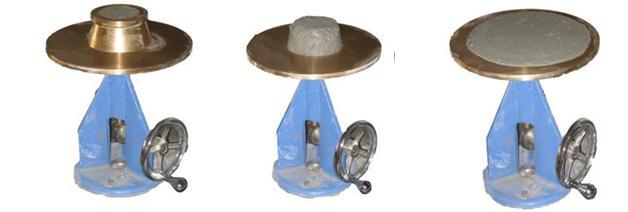
P = Maximum Load at failure (N) A= Cross sectional area (mm2)
Figure 3.9 Compression Testing Machine
3.5.2.
Flexural strength Test
Flexuralstrengthisameasureoftensilestrengthinbending.Flexuralstrengthtestingiscarriedoutona40mmx 40mmx160mmcementmortarbeam.Therearetwobasicflexuraltests:thethird-pointloadingandthecenter-
International Journal of Trend in Scientific Research and Development @ www.ijtsrd.com eISSN: 2456-6470

point loading. For the third-point loading test the beam is supported on each end and loaded at its third points andforthecenter-pointloadingtestthebeamisloadedatthemiddleuntilfailure.Themodulusofruptureisthen calculated and reported as theflexural strength. Thethird-point loadingtest is preferredbecause,ideally,in the middlethirdofthespanthesampleissubjectedtopuremomentwithzeroshear.Inthecenter-pointtest,thearea ofeventualfailurecontains not onlymoment induced stressesbut also shearstress andunknown areas ofstress concentration.Placethebeaminthetestingmachineasshownin Figure3.10withitslongitudinalaxisnormalto the supports. Apply the load vertically at the rate of 50 ±10 N/s until fracture. Three beam specimens for each test age where tested as per ASTM C 78 to determine the flexural strength of all the nine mixes.
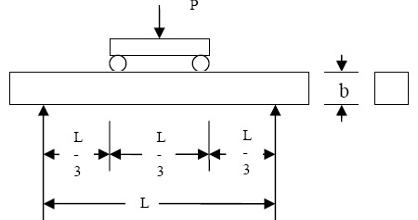
Flexural strength was calculated as;
Where;
Flexural strength (MPa)
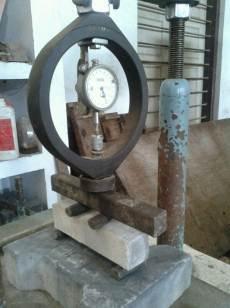
M= Maximum bending moment (Nmm)
Z= Section modulus (mm3)
3.5.3.
Sulphate attack Test
Figure 3.10 Third Point loading method
Fig 3.11 Flexural strength test on mortar beam
Sulphate attack is one of the most severe environmental deteriorations that affect the long-term durability of concrete.Thetermsulphateattackdenoteanincreaseinthevolumeofcementpasteinconcreteormortardueto thechemical action betweentheproducts ofhydrationofcementandsolutioncontainingsulphates.Becauseof the increase in volume of the solid phase, a gradual disintegration of concrete takes place. The resistance of mortar specimens against sulphate attack was determined as per ASTM C 1012. 50 mm x 50 mm x50 mm cube specimens were subjected to initial water curing for 3 days and then were transferred to a
International Journal of Trend in Scientific Research and Development @ www.ijtsrd.com eISSN: 2456-6470

20000ppmsulphatesolutionpreparedbydissolving52gmofMgSO4.7H2Oinonelitreofwater.After7,28,56 and 90 days of sulphate exposure the effect of sulphate attack was determined from the mass loss and also comparing the compressive strength of the specimens with the strength of water cured specimens. Fig 3.11 shows mortar specimens subjected to sulphate attack.
Fig 3.12 Mortar specimens subjected to sulphate attack
3.5.4. Sulphuric Acid Attack Test
When concrete or mortar samples are exposed to acid solutions (pH less than 6.5) it will result in slow or rapid disintegration of the samples depending on the type and concentration of the acid.
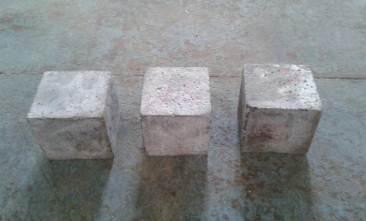
To check the resistance of the mortar mixes against sulphuric acid, mortar cube specimens of size 50mm x 50mmx50mmwereexposedto3%sulphuricacidsolution,afterinitialwatercuringofthreedays.After7,28,56 daysand90daysofacidexposure,specimensweretestedforcompressivestrength.Thecompressivestrengthof acid cured samples was then compared with the compressive strength of water cured samples, to determine the effect of acid attack. Fig 3.12 shows mortar specimens subjected to acid attack.
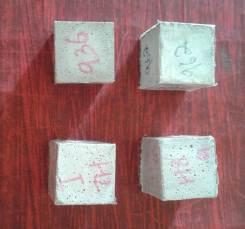
Fig 3.13 Mortar specimens subjected to acid attack
3.5.5. Rapid Chloride Permeability Test (RCPT)
Rapid chloride permeabilitytest measures the electrical conductance of mortar samples, which is a measure of resistance of mortar samples to chloride ion penetration.Itwas performed on 100mm diameter and 50mm thick mortardiscspecimens, asperASTMC1202-94. InRCPT,thediscspecimenisfittedbetweentwocellshaving aholeof10cmdiameteratitscentercoveredbyapocketorreservoirforfillingthesolution.Oneofthefacesof the specimen is exposed to 3% NaCl solution and the other face is exposed to 0.3 M NaOH solution. Electrode dippedin NaCl will beconnectedto thenegativeterminal ofthepowersupplyandthatofNaOHto thepositive terminal.Electricalconnectionstovoltageapplicationanddatareadoutapparatus;i.e.amillimeterismade.60V dc is applied across the faces continuously for a period of 6 hours and the current between the electrodes is monitored at 30 minutes interval.
The total charge passed is a measure of the electrical conductance of the concrete during the period of the test and is calculated by the formula
Q = 900(I0 + 2I30 + 2I60 + ….. + 2I300 + 2I330 + I360)
Where
Q = charge passed (coulombs)
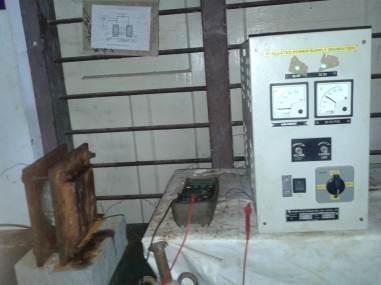
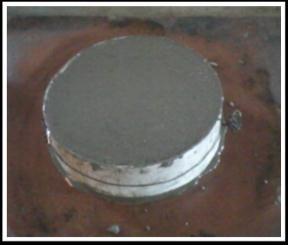


3.5.6. Sorptivity Test
Water is generally involved in everyform of deterioration, and in porous solid, permeabilityof the material to water usuallydetermines therate of deterioration. Thepermeabilityof amortarorconcretesurfacedepends on many factors like mixture proportions, presence of chemical admixtures and supplementary cementitious materials, composition and physical characteristics of the cementitious component and of the aggregates, the entrained air content, type and duration of curing, presence of micro cracks, etc.
This method is intendedtodetermine the susceptibilityofan unsaturated mortarspecimen to thepenetrationof water. The water sorptivity test on mortar measures the rate of movement of water through the mortar under capillary suction. It involves measuring the increase in the mass of a specimen resulting from absorption of water as a function of time when only one surface of the specimen is exposed to water. The lower the water sorptivity index, the better is the potential durability of the mortar.
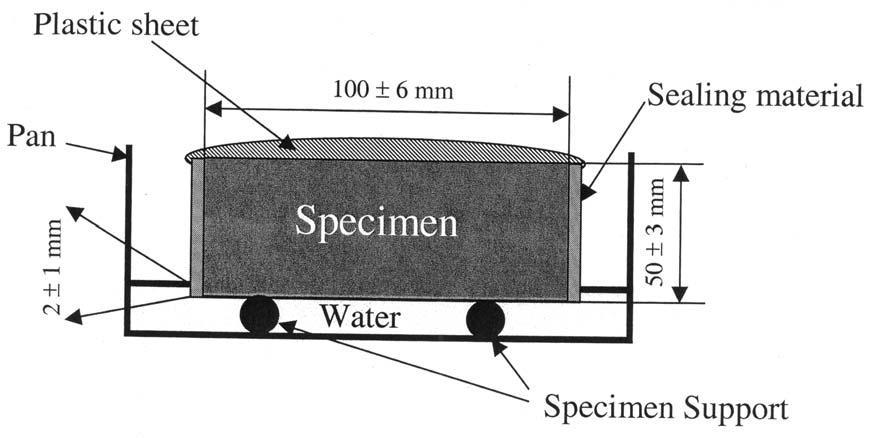
SorptivitytestwasconductedasperASTM C1585,thetestconsistofexposingthebottomsurfaceofthesample towaterandmeasuringtheincrementinmassresultingfromabsorptionofwater.Onlyonesurfaceisexposedto water while the other surfaces are sealed simulating water absorption in a member that is in contact with water on one side only.
The test was conducted on 100mm x 50mm disc specimens, after subjecting to water curing for 28days. The specimens are then oven dried at a temperature of 50°C for 3 days. The oven dried samples are then allowed to cool in thelaboratorycondition. Afterweighingthespecimens areplaced onasupportinsideatraywith water, insuchawaythatwaterlevelis1mmto3mmabovethetop ofthesupportdevice.Theflowfromtheperipheral surface is prevented bysealingit properlywith non-absorbent coating.The test setup is shown in Fig 3.16. The massofthespecimenismeasuredat0,60,300,600,1200,1800,3600,7200,10800,14400and18000secondsafter wipingexcesswaterfromthebottomsurfaceusingadampcloth.Theabsorption, I,isthechangeinmassdivided by the product of the cross-sectional area of the test specimen and the density of water. For the purpose of this test, the temperature dependence of the density of water is neglected and a value of 0.001 g/mm3 is used.
Where, I = normalized absorbed water (mm) = change in specimen mass at time t (g) a= area of specimen exposed to water (mm2) d= density of water (g/ mm3)
Theinitial rateof water absorption orsorptivity(mm/s1/2)is definedas theslopeof theline thatis the best fit to Iplottedagainst thesquarerootoftime(s1/2).Obtainthis slopebyusingleast squares, linearregression analysis of the plot of I versus time1/2 .
Fig 3.17 ASTM C 1585-04 standard test setup
4. RESULTSAND DISCUSSION
4.1. GENERAL
Thestrength and durabilitystudies wereconducted onall theninemixes accordingto theprocedures described inthepreviouschapter.Theresultsobtainedweretabulatedandadetailedanalysisanddiscussionontheresults

International
is presented in this chapter.Each test result plotted in the figures or in the tables is the mean value of results obtainedbytestingthreespecimens.Theinterpretationoftheresultsobtainedisbasedonthecurrentknowledge available in the literature as well as on the nature of results obtained.

4.2. SUPERPLASTICISER DEMAND
Flowtabletestwasconductedforalltheninemixes,todeterminethesuperplasticizerdosagerequiredtoobtain a workability of 110±5%. Figure 4.1shows the quantity of superplasticiser required for 1kg of cementitious materials.
It can be seen that as the fly ash content increases superplasticiser demand decreases. This is due to spherical shape and smooth surface of fly ash particles. The smooth spherical fly ash particles act as small bearings to reduce the inter-particle friction in the mixture, thereby improving the workability and decreasing the superplasticiserdemand.Fromthefigureitcanbeobservedthatanincreaseinsilicafumecontentincreasesthe superplasticiser demand. This increase in superplasticiser demand or reduced workability is due to extremely fineparticlesizeofsilicafume(highersurfacearea)thusresultinginagreatersuperplasticiserdemand.Ternary mixtures followed the trends of their constituent materials; i.e. for both ternaryand binarymixes an increase in fly ash content improves workability and increase in silica fume content decreases workability. Minimum superplasticiser demand is observed for F(30)S(0) mix and F(30)S(5) mix and maximum superplasticiser demand is observed for F(0)S(10)mix.
Figure 4.1 Superplasticiser demand for various mixes
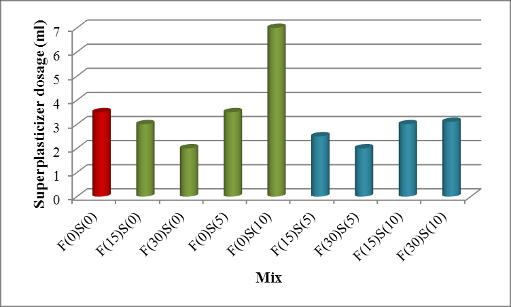
4.3. UNIT WEIGHT
After demoulding the specimens, the unit weights of all the nine mixes were measured and the results are as presented in Table 4.1.It can be seen that maximum unit weight is obtained for control mix. As expected, the unit weight of the mortars with binaryand ternary blends decreased with an increase in FA and SF content due to their low unit weight compared to that of cement. The unit weight of mortars with binary blends of FA/SF varied between 2.29 and 2.42 kg/m3 whilst the unit weight of ternary blends of FA and SF ranged between2.25and 2.43 kg/m3
Table 4.1
Unit weight of various mixes
Mix Unit weight (Kg/m3)
F(0)S(0) 2.460
F(15)S(0) 2.420
F(30)S(0) 2.415
F(0)S(5) 2.359
F(0)S(10) 2.290
F(15)S(5) 2.430
F(30)S(5) 2.266
F(15)S(10) 2.310
F(30)S(10) 2.256
4.4. COMPRESSIVE STRENGTH
Compressive strength studywas carried out on 50mm x 50mm x 50mm cube specimens at the ages of 7, 28, 56 and 90 days. Three specimens were tested at specified ages for all mixes. Table 4.2 shows the compressive strength values of all the nine mixes at different test ages.
Table 4.2 Compressive strength of different mixes Mix Cube Compressive strength N/mm2 7 days 28 days 56 days 90 days
F(0)S(0) 23.20 32.70 40.80 42.00
F(15)S(0) 23.73 36.00 42.70 44.00
F(30)S(0) 21.60 30.80 37.06 37.07
F(0)S(5) 24.30 34.40 41.80 43.70
F(0)S(10) 24.92 34.90 42.60 44.1
F(15)S(5) 22.93 33.20 36.00 37.33
F(30)S(5) 22.67 32.46 35.47 37.20
F(15)S(10) 20.00 37.20 44.00 48.00 F(30)S(10) 18.13 35.02 37.33 38.40
4.4.1. Compressive Strength of Binary Mixes
A. OPC + FAmix
Fig 4.3 shows the compressive strength variationof control mix and binary blends of fly ash and ordinary Portlandcement.Fromthefigureitcanbeseenthatflyashimprovesthestrengthatlowreplacementlevelandat later ages. F (15)S(0) mix with 15% fly ash, gives better strength than the OPC mix. It may be due to the filler effect and pozzolanic reaction of fly ash. But the increase in strength of F(15)S(0) mix over control mix is significant at later ages only( 28 days onwards). It may be attributed to the fact that, the pozzolanic reaction of fly ash is a slow process and hence its contribution to strength development occurs only at later ages.
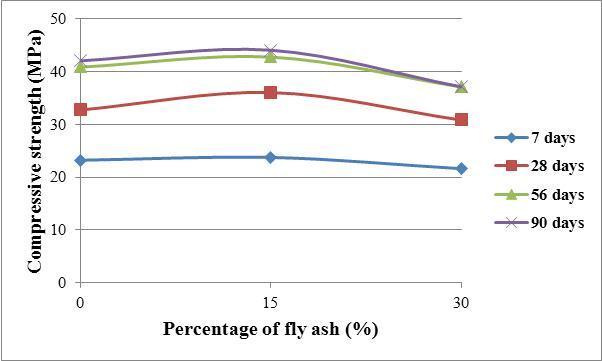
When the fly ash content is increased to 30% in F (30)S(0) mix, the strength decreases and it is lower than the controlmix.ItmaybeduetothefactthatathigherreplacementlevelsPortlandcementcontentlevelwillbeless which in turn reduces the amount of C-S-H gel resulting from the hydration of ordinary Portland cement.
Fig 4.3 Compressive strength development of control and OPC+FAmixes
B. OPC+SF mix
Fig4.4showsthecompressivestrengthdevelopmentincontrolmixandbinaryblendsofOPCandSF.Fromthe plot it is clear that as the silica fume content increases, the compressive strength also increases at all ages. ReplacingOPCwithSFresultedinstrength gainof4%and5%inF(0)S(5)andF(0)S(10)mixesrespectivelyat 90 days.

International Journal of Trend in Scientific Research and Development @ www.ijtsrd.com eISSN: 2456-6470

Improvement in compressive strength of mortar with the addition of silica fume may be explained by the chemical and physical effects of silica fume. Chemical effect is due to the pozzolanic reaction of silica fume. Silicafumeconsumethecalcium hydroxide(Ca(OH)2)crystals released from thehydrationprocess, leadingto the formation of further calcium silicate hydrate (secondary C-S-H gel) and thus improves the interfacial bond strengthbetweenaggregateparticlesandthematrix.Thephysicaleffectcanbeattributedtothefillereffect.Due to its small particle size it gives a denser microstructure, as evident from the scanning electron microscopy image, thereby providing greater strength.
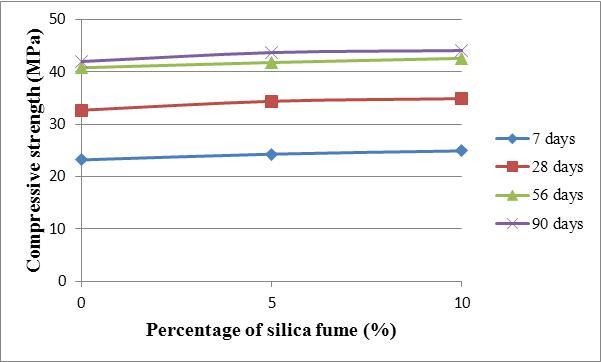
Fig 4.4 Compressive strength development of control and OPC+SF mixes

4.4.2. Compressive strength of ternary mixes
FromFig4.5andTable4.1itcanbeseenthattheternarymixF(15)S(10)showsbettercompressivestrengththan the control and other binary and ternary mixes. It shows 14.3% increase in strength when compared to the control mix.The behaviour of ternarymixes was in accordance with the trend predicted bythe binary mixes. It can be seen that the effectiveness of silica fume in increasing the compressive strength of ternary blends was insignificant in mortar mixes with high fly ash content.
Fig 4.5 Compressive strength development of control and ternary mixes
Fig4.6showsthevariationof90dayscompressivestrengthwithpercentageofcementreplaced.Fromthefigure it may be noted that maximum compressive strength is obtained for ternary blend F(15)S(10), with a cement replacement level of 25%. When the replacement level is increased beyond 25% the compressive strength decreases.
Fig 4.6 Compressive strength Vs percentage of cement replaced 4.5. FLEXURALSTRENGTH
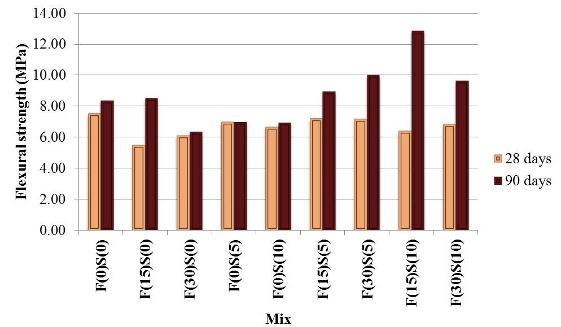
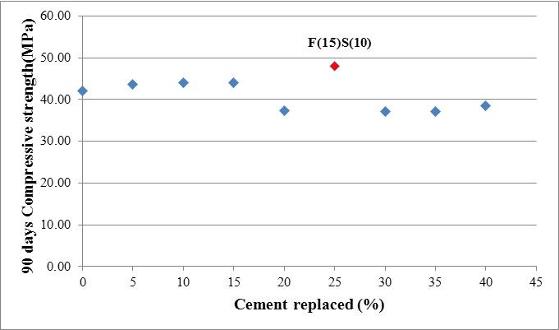
Beam specimens of size 40mm x 40mm x 160 mm were tested for determiningthe flexural strength of the nine mixes. Fig 4.7 shows the variation of flexural strength for all the mixes. From the figure it can be seen that all theternarymixes gives superiorperformance whencomparedto the control andbinarymixes. It maybedueto the filler effect and increased pozzolanic action by the addition of silica fume and fly ash. Maximum flexural strength of 12.85MPa is obtained for mix F(15)S(10).From the figure it is evident that better performance of ternary mixes is evident at later ages, because the pozzolanic reaction of fly ash is a slow process and hence its contribution to strength development occurs only at later ages.
Fig 4.8 shows the rate of strength development in different mixes. From the Fig 4.8 it can be clearly seen that rateofstrength development in ternarymixes is greaterthanthecontrol andbinarymixes, andmaximum value is obtained for F (15)S(10).
Fig 4.7Flexural strength of various mixes

Fig 4.8Rate of increase in flexural strength with age 4.6.
SULPHATEATTACK TEST
The resistance of mortar specimens against sulphate attack was determined on cube specimens of size 50mm x 50mmx50mm,immersedinsulphatesolution.Afterexposuretosulphatesolution,whitepatcheswerefoundon the surface of mortarspecimens. The compressive strength variation of the specimens subjected to sulphate attack is as shown by Fig 4.9, Fig 4.10 and Fig 4.11. From Fig 4.9it can be seen that compressive strength of sulphatecured samples increases as flyash content increases. Similarlyfrom Fig4.10it is seenthatan increase insilicafumecontentresultsinincreaseincompressivestrengthofsulphatecuredsamples.FromFig4.11itcan be seen that all the ternary mixes show better sulphate resistance when compared to the OPC control mix.
The superior performance of blends may be due to reduced permeability and pozzolanic action. When supplementarycementitious materials like flyash and silica fume are added, particles pack more tightly, hence there will be lesser voids, which in turn reduce permeability and improve sulphate resistance. Moreover pozzolanic reaction of silica fume and fly ash produces additional C-S-H gel or bond which grows into the capillary spaces that remain after hydration and improves the strength of matrix against sulphate attack. Maximum sulphate resistance is observed for F(15)S(10) mix. The 90 days strength of F(15)S(10) mix is 41.86MPa, which is about 15% greater than OPC control mix.
Table 4.3 Compressive strength of different mixes exposed to sulphate attack Mix
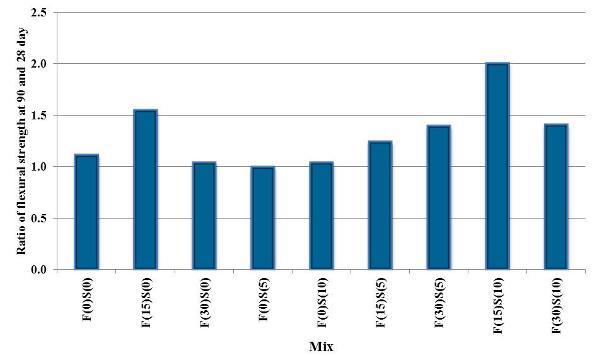
Compressive strength (N/mm2) 7 days 28 days 56 days 90 days
F(0)S(0) 18.00 26.40 31.20 36.27
F(15)S(0) 22.40 30.40 35.20 36.60
F(30)S(0) 24.80 30.40 36.00 37.00
F(0)S(5) 20.53 28.00 37.00 38.93
F(0)S(10) 20.00 28.00 39.20 41.06
F(15)S(5) 22.67 26.80 36.00 35.73

F(30)S(5) 23.20 29.86 34.40 36.00
F(15)S(10) 23.73 33.60 37.60 41.86 F(30)S(10) 20.26 29.60 36.00 36.53
Fig 4.9 Compressive strength development of control and OPC+FAmixes subjected to sulphate attack
Fig 4.10 Compressive strength development of control and OPC+SF mixes subjected to sulphate attack

Fig 4.11Compressive strength of control and ternary mixes subjected to sulphate attack
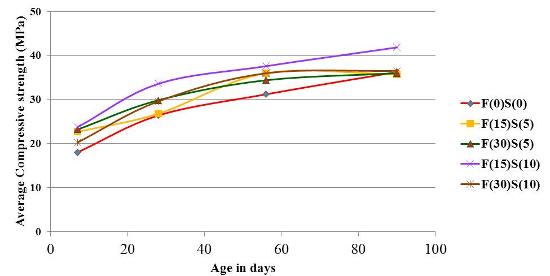
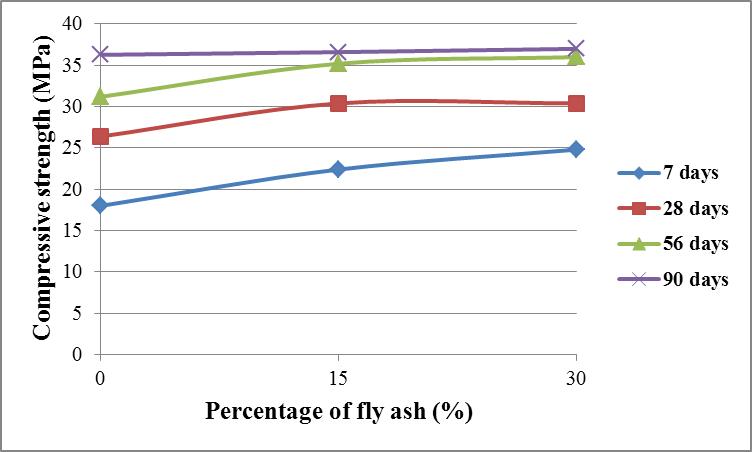
www.ijtsrd.com eISSN: 2456-6470

The reduction of compressive strength due to acid attack was expressed in the form of strength deterioration factor (SDF).Fig 4.12 shows the SDF of different mixes when immersed in sulphate solution for 90 days.The results indicatethat at higherlevels offlyash, strength deterioration undersulphateattackis less. It mayalso be noted that SDF value of all ternary mixes were less than the control mix. This higher resistance to sulphate attack might be because of the dense impermeable nature of the ternary mixes, due to the reduction of micro poresinthematrixontheadditionofFAandSF.ThebinarymixF(30)S(0)suffersminimumstrengthlosswhen subjected to sulphate attack.
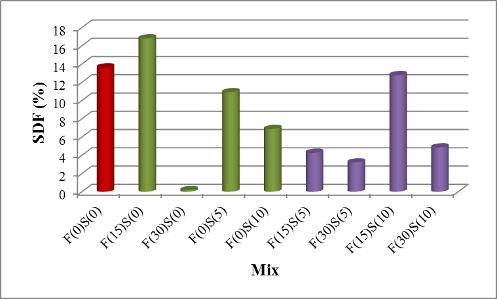
Fig 4.12 SDF values for various mixes when subjected to sulphate attack
4.7.
SULPHURICACID ATTACK TEST
Table 4.4 shows the compressive strength of different mixes subjected to sulphuric acid attack. Fig4.13 shows thecompressivestrength ofcontrolandbinarymixcontainingflyashaftersulphateexposure.Fromthefigureit can be seen that at 7, 28 and 56 days there is no commendable increase or decrease in the compressive strength with the addition of fly ash i.e. Binaryblends give almost same result as that of OPC control mix.This may be due to the slow reaction rate of fly ash. At 90 days, mix with 15% fly ash shows better acid resistance when compared to thecontrol mix; it maybe attributedtothereducedpermeabilitydueto the addition offlyash. But whenflyashcontentisincreasedfurtherto30%thestrengthdecreases.This reductioninstrengthat30%flyash content may be due to deficiency of ordinary Portland cement in the mix.
Fig 4.14 shows the compressive strength development of control mix and binary blends of OPC and SF. From the figure it can be seen that incorporation of silica fume does not improve the acid resistance.When subjected to acid attack the binary blends of silica fume showed reduced strength when compared to OPC mix. Fig 4.15 showsthebehaviorofternaryblendsunderacidattack.Itcanbeseenthatatlaterages(56daysonwards)ternary mix F(15)S(10) showed better acid resistance than the control mix.All other ternary mixes showed poor acid resistance when compared to the control mix.
Table 4.4 Compressive strength of various mixes subjected to acid attack Mix
Compressive strength (N/mm2)
7 days 28 days 56 days 90 days
F(0)S(0) 22.93 29.60 32.80 37.86
F(15)S(0) 22.93 28.53 32.80 43.20
F(30)S(0) 23.20 28.00 32.00 36.20
F(0)S(5) 24.00 27.20 30.40 34.26
F(0)S(10) 23.20 28.00 32.00 36.00
F(15)S(5) 21.86 22.40 31.20 34.93 F(30)S(5) 22.40 17.87 29.60 36.40 F(15)S(10) 25.06 24.80 34.93 43.20 F(30)S(10) 18.93 34.93 33.60 35.46
Fig 4.13 Compressive strength of control and OPC+FAmixes subjected to acid attack

Fig 4.14 Compressive strength of control and OPC+SF mixes subjected to acid attack
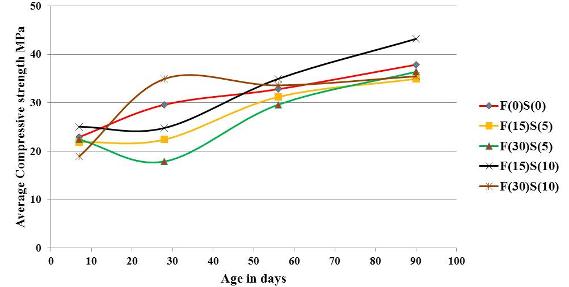
Fig 4.15Compressive strength of control and ternary mixes subjected to acid attack

@ www.ijtsrd.com eISSN: 2456-6470

The reduction of compressive strength due to acid attack was expressed in the form of strengthdeterioration factor (SDF).Fig 4.16 shows the SDF of different mixes when immersed in acid solution for 90 days. It maybe notedthatthebinarymixF(15)S(0)suffersminimumstrengthlosswhensubjectedtosulphuricacidattack.The SDFvalue of all ternarymixes was lessthanthe control mix. This higher resistanceto sulphate attackmight be due to reduced permeability of ternary mixes due to denser microstructure. It may also be noted that binary blends of SF suffered maximum strength loss.
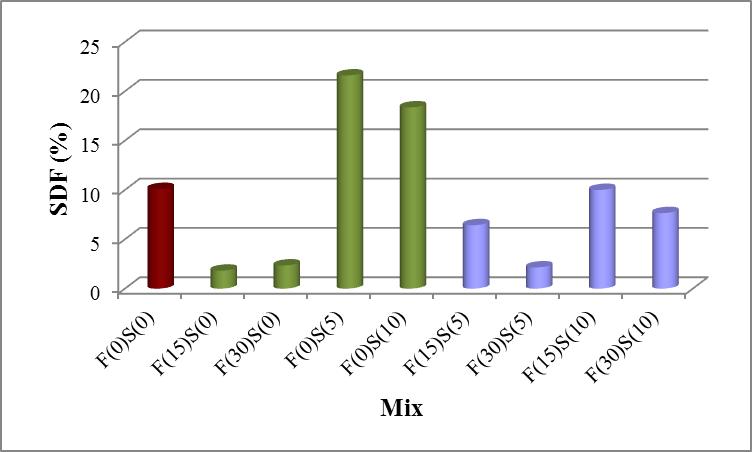
Fig 4.16 SDF values for various mixes when subjected to sulphuric acid attack
4.8. Rapid Chloride Permeability Test (RCPT)
ThedetailsofchargepassedthroughdifferentmixesareshowninTable4.5.Fig4.17showsthevariationoftotal chargepassedwith flyashcontentandFig4.18showsvariationoftotal chargepassedwithsilicafumecontent. It can be seen that an increase in fly ash content and silica fume content, in respective binary blends of fly ash and silica fume, results in increase of resistance to chloride ion penetration.
Fig 4.19 shows the variation of total charge passed in different mixes. It may be noted that ternary blends showed higherresistance to chlorideion penetrationwhencomparedto both control andbinarymixes. Highest amountofchargeispassedthroughcontrolmixandleastchargeispassedthroughternaryblendF(30)S(10)mix. Thus the results clearly indicate that addition of fly ash and silica fume in mortar mixes reduces the chloride permeability. The reduced charge in the ternary and binary blends may be attributed to finer pore sixe distributionwhencomparedto controlmix.Thisresultsindecreasedcapillaryporosity,whichinturnincreases resistance against chloride ion penetration.
Table 4.5Chloride Permeability of Different Mixes at 90 days Mix
Total charge passed (Coulombs)
F(0)S(0) 751.86
F(15)S(0) 653.67
F(30)S(0) 383.58
F(0)S(5) 647.46
F(0)S(10) 501.66
F(15)S(5) 364.77
F(30)S(5) 274.95
F(15)S(10) 201.51
F(30)S(10) 141.84
Fig 4.17 Total charge versus Percentage of fly ash

Fig 4.18 Total charge versus Percentage of silica fume
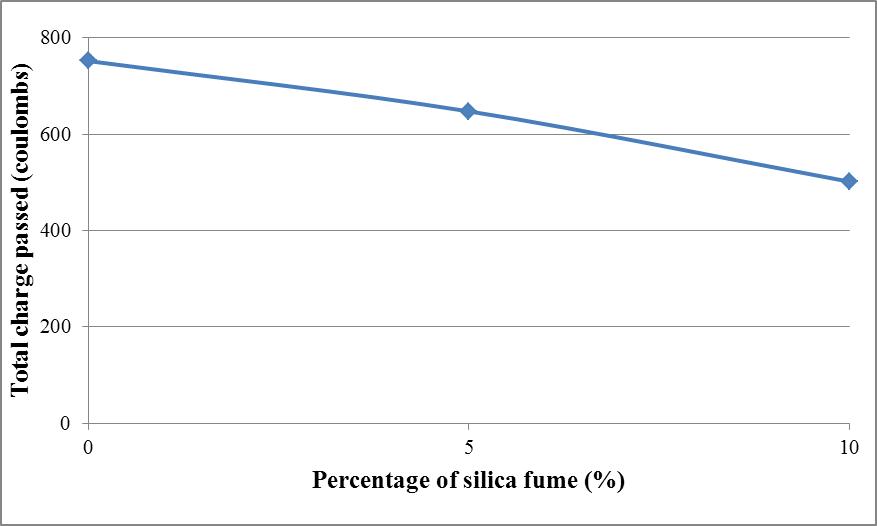
Fig 4.19 Total charge passed through different mixes

Fig 4.20 shows the variation of total charge passed through the specimens with the initial current observed during the commencement of the test.

Fig 4.20Total Charge passed vs. Initial Current at 90 days
4.9. SORPTIVITYTEST

Sorptivitytest was conductedon100mm x 50mm discspecimens after 28days ofwater curing, as explained in the previous chapter.Absorption of water (I) by all the mixes, in the first six hours was measured.Absorption measurementsarethenplottedasafunctionofsquarerootoftime.Sorptivityistakenastheslopeofthecurve(I vs.√t) during first six hours. The sorptivity values of all the nine mixes are presented in Table 4.6.
From Fig 4.21 it can be seen that binary and ternary mixes gave superior performance when compared to the control mix. Control mix exhibited a maximum sorptivity of 0.0085mm/s1/2, and minimum sorptivity of 0.0041mm/s1/2 wasobtainedforternarymixF(30)S(5).Onanaveragesorptivityofbinaryblendsofflyashwas 36% lesser than control mix and sorptivity of binary blends of silica fume were 32% lesser than control mix. Sorptivity of ternary blends decreased on an average of 41% over the control mix. Thus the results indicate that inclusion of fly ash and silica fume reduces the water absorption of mortar specimens. This may be due to the filler effect of fine fly ash and silica fume particles, which makes the water passage harder. When fly ash and silica fume are added particles pack more tightly with lesser voids, thereby reducing permeability and sorptivity.
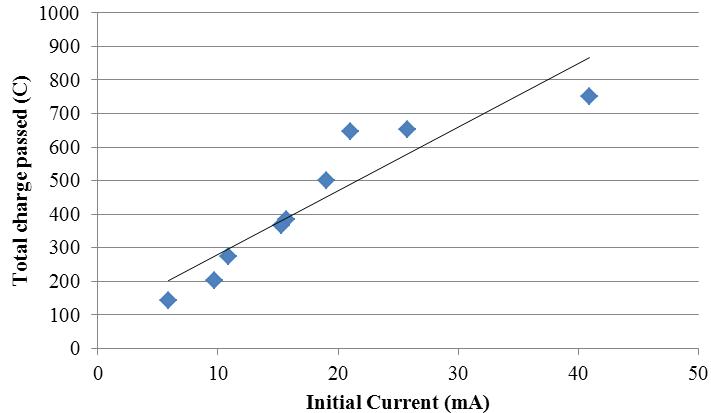
Table 4.6Sorptivity of various mixes Mix Sorptivity
(mm/s1/2 )
F(0)S(0) 0.0085
F(15)S(0) 0.0052
F(30)S(0) 0.0056
F(0)S(5) 0.0066
F(0)S(10) 0.0049
F(15)S(5) 0.0045
F(30)S(5) 0.0041
F(15)S(10) 0.0043
F(30)S(10) 0.0042
Fig 4.21Sorptivity of various mixes
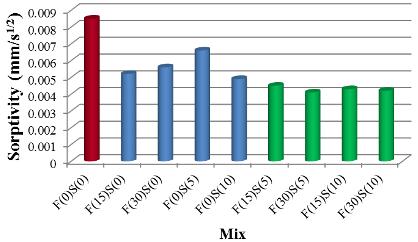
4.10. QUANTIFICATION OFSYNERGY
The theoretical values of the strength and durability properties of ternary mixes were calculated using the equationdescribedinthepreviouschapterandthemagnitudeofsynergisticeffect(S.E)wascalculatedusingthe equation:

WhereSEisthesynergisticeffect (%),P actual isameasuredvalueofagivenproperty,P theorisatheoreticalvalue of a given property and j = 1 for properties to be maximized (compressive strength) and j = -1 for properties to be minimized (rapid chloride permeability and initial sorptivity).
Figure 4.22 shows the synergistic effect in the development of 90 days compressive strength of the ternary blends.FromthefigureitmaybenotedthattheternarymixF(15)S(0)whichgavesuperiorcompressivestrength when compared to the control and binary mixes showed a maximum synergy of 5.3%. The SE values for all other ternary blends are typically negative, implying lack of any synergistic effect.
Fig 4.22 Synergistic Effect Vs Mix for 90 days compressive strength
Fig 4.23 shows the values of S.E for 90 days flexural strength of various ternary blends. It can be seen that all the ternary blends showed positive synergy. F(30)S(5) mix showed a Maximum S.E value of 82%.
Fig 4.23Synergistic Effect Vs Mix for 90 days Flexural strength

Figure 4.24 shows the synergistic effect in the development of 90 days compressive strength of the ternary blendssubjectedtosulphateattackandacid attack. It canbeseenthatwhentheternarymixesweresubjectedto sulphate attack only mix F(15)S(10) showed positive synergy. Under acid attack all the ternary mixes except F(15)S(5) showed positive synergy.

Fig 4.24Synergistic Effect versus Mix

Figure4.25showsthevaluesofS.Eforresistancetochlorideionpenetration(RCP)ofvariousternaryblends.It may be noted that all the ternary blends gave a positive S.E value. This implies that the excellent resistanceto chlorideionpenetrationobservedfortheternarymixesisattributabletothesynergisticinteractiontakingplace between fly ash and silica fume. Maximum S.E value is obtained for F(15)S(10) mix.

Fig 4.25 Synergistic Effect versus Mix for RCP


Fig 4.26 shows the values of S.E for sorptivityof various ternaryblends. It maybe noted that the ternaryblend with least sorptivity showed maximum positive synergy of 7.2%. All other ternary blends showed negative synergy.
This however, does not necessarily imply that these mixes performed poorly. Quite the opposite the mix F(15)S(5) performed better than the control and binary mixes.
Fig 4.26 Synergistic Effect versus Mix for sorptivity
5. CONCLUSION
5.1.
GENERAL
An investigation was carried out on the strength and durability properties of mortars with binary and ternaryblendedcementitiousmaterials.Twokindsof supplementarycementitiousmaterialsnamelyflyash and silica fume were blended with ordinary Portland cement to produce mortar for testing. The effects of binaryandternaryblendingofflyashandsilicafume with ordinary Portland cement were studied. A subsequent objective of the study was to verify and quantify synergistic effects in a ternary cementitious system containing fly ash, silica fume and ordinary Portland cement. The conclusions drawn from the present investigation based on the limited observations made during the study period and the scope for the future work are presented in this chapter.
5.2.
CONCLUSIONS
Test results have shown that the ternary blended mixturesoverallimprovedthemortarperformanceby improving the workability, strength and durability, therefore are applicable. Ternary mixtures overall performed in accordance with their ingredients; however the degree of improvement that they contribute varies based on the selected dosage and type of SCMs. The following conclusions are made based on the results:
At constant water binder ratio, superplasticiser demanddecreaseswithincreaseinflyashcontent andincreaseswithincreaseinsilicafumecontent, i.e. fly ash improves workability and silica fume decreases workability.
Maximum dryunit weight is obtained for control mix. The unit weight of the mortars with binary and ternary blends decreased with an increase in FA and SF content.
Flyashimprovesthecompressivestrengthonlyat low replacement level and at later ages.
Increase in silica fume content increases compressive strength at all ages.
Maximumcompressivestrengthwasobtainedfor ternary mix F(15)S(10). It showed a 14.3% increase in 90 days compressive strength when compared to control mix.
When the cement replacement level is increased beyond 25%, compressive strength decreases.
All ternarymixes showed better flexural strength when compared to control and binary mixes. Maximum flexural strength was obtained for ternary mix F (15) S(10).
Increaseinflyashcontentandsilicafumecontent increases the compressive strength of mortar specimens subjected to sulphate attack.
Under sulphate attack all ternary blends outperformed control mix, they suffered minimum strength deterioration when compared to control mix. Maximum compressive strength was obtained for F(15)S(10) mix.
The compressive strength of control mix and binary blends of fly ash, subjected to acid attack are comparable at 7, 28 and 56 days of acid exposure.At90daysbinarymixwith15%flyash showed greater compressive strength when compared to control mix.
Incorporation of silica fume does not improve acid resistance.
Addition of fly ash and silica fume increases the resistance to chloride ion penetration. Maximum resistancetochlorideionpenetrationwasreported for ternary mix F(30)S(10) mix.
Inclusion of SCMs like fly ash and silica fume reducesthewaterabsorptionofmortarspecimens. Minimumsorptivitywasobtainedforternarymix F (30)S(5).
5.3.
SCOPE FOR FUTURE WORKS
Effect of variation in mix composition can be studied by changing the fly ash content and the silica fume content.
Effect of variation of water binder ratio on the strength and durability properties of ternary blends may be studied.

Additional tests may be conducted to determine theeffectofternaryblendingoncarbonationrate.
The investigation may be extended to ternary blendingofordinaryPortlandcement,flyashand silica fume in concrete.
Petrographical study on the mineral formation of different ternary blends during hydration may be studied.
The effect of quaternary blends on strength and durability parameters can be investigated.
6. REFERENCES
[1] Ahmed, S., K. Obada and A. Wendy (2009), Evaluation of binary and ternary blends of pozzolanic materials using rapid chloride penetration test, Journal of materials in civil engineering ASCE, 21, 446-453
[2] Antihos, S. K., V. G. Papadakis and E. Chaniotakis(2007)Improvingtheperformance ofblendedcementsbymixingdifferenttypesof
International Journal of Trend in Scientific Research and Development @ www.ijtsrd.com eISSN: 2456-6470

fly ashes, Cement and Concrete Research, 37, 877-885
[3] Appa, G. R. (2003) Investifgation on the performanceofsilicafumeincorporatedcement pastes and mortars, Cement and Concrete Research, 33, 1765-1770
[4] Chindaprasirt, P., S. Homwuttiwongand V. Sirivivatanon(2004) Influence of fly ash fineness on strength, drying shrinkage, and sulphate resistance of blended cement mortar, Cement and Concrete Research,34,1087-1092
[5] Chindaprasirt, P., S. Rukzon (2008) strength, porosity and corrosion resistance of ternary blend Portland cement, rice husk ash and fly ash mortar, Construction and Building Materials, 22, 1601-1606
[6] Isaia, G. C., A. L. G. Gastaldiniand R. Moraes(2003) Physical and pozzolanic action ofmineraladditionsonthemechanicalstrength of high-performance concrete, Cement & Concrete Composites, 25, 69–76
[7] Ji, Y. and J. H. Chayaadi (2003) Effects of densifiedsilicafume onthemicrostructureand compressivestrengthofblendedcementpastes, Cement and Concrete Research,33,1543-1548
[8] Kazim, T (2012) Viscosity and hardened properties of self-compacting mortars with binary and ternary cementitious blends of fly ash and silicafume, Construction and Building Materials, 37, 326-334
[9] Khan, M, I., C. J. Lynsdale and P. Waldron (2000) Porosity and strength of PFA/SF/OPC ternary blended paste, Cement and Concrete Research, 30, 1225-1229
[10] Mohammad, I. K and R. Siddique(2011) “ Utilization of silica fume in concrete : review of durability properties” Conservation and Recycling, 57, 30-35
[11] Nehdi, M., S. Mindess and P. C. Aitcin (1996), Optimisation of triple blended composite cement for making high strength concrete, World cement Research and Development, 27, 69-73
[12] Nochaiya, T., W. WongkeoandA. Chaipanich (2010), Utilisation of fly ash with silica fume and properties of Portland cement- fly ashsilica fume concrete, Fuel, 89, 768-774.
[13] Olek,J andM Radlinski,(2012),Investigation into the synergistic effects in ternary cementitious systems containing Portland cement, fly ash and silica fume, Cement and Concrete Research, 34, 451-459.
[14] Tahir, K E andO Kırca (2008) Use of binary and ternary blends in high strength concrete, Construction and Building Materials, 22, 1477–1483
[15] Thomas, M D A., M A Shehataand K Cail(1999), Use of ternary cementitious systems containing silica fume and fly ash in concrete, Cement and Concrete Research, 29, 1207-1214.
[16] Yurdakul, E., P C Taylor and F Bektar (2013), Effect of water to binder ratio, air content and type of cementitious materials on fresh and hardened properties of binary and ternary blended concrete, Journal of materials in civil engineering
